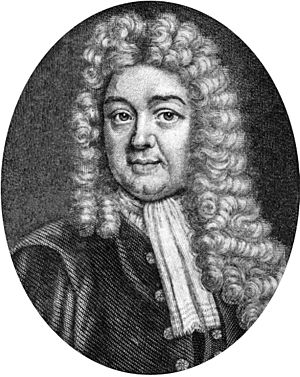John Radcliffe (physician) facts for kids
Quick facts for kids
John Radcliffe
|
|
|---|---|
 |
|
| Member of Parliament for Bramber | |
| In office 20 March 1690 – 11 October 1695 |
|
| Monarch | William III |
| Preceded by | John Alford |
| Succeeded by | Nicholas Barbon with William Stringer |
| Member of Parliament for Buckingham | |
| In office 12 November 1713 – 1 November 1714 |
|
| Monarch | Anne I |
| Preceded by | Thomas Chapman |
| Succeeded by | Alexander Denton and Abraham Stanyan |
| Personal details | |
| Born |
John Radcliffe
1650 Wakefield, Yorkshire, England |
| Died | 1 November 1714 (aged 63–64) |
| Political party | Tory |
| Alma mater | University College, Oxford, Lincoln College, Oxford |
John Radcliffe (born 1650 – died 1 November 1714) was a famous English doctor, scholar, and politician. Many important buildings in Oxford are named after him. These include the Radcliffe Camera, the Radcliffe Infirmary, and the John Radcliffe Hospital.
Contents
Life of John Radcliffe
John Radcliffe was born in Wakefield, Yorkshire, in 1650. His parents were George Radcliffe and Anne Loader. He went to Queen Elizabeth Grammar School and Northallerton Grammar School.
He later studied at the University of Oxford. He was a special student called an exhibitioner at University College, Oxford. He then became a Fellow at Lincoln College, Oxford. In 1682, he earned his medical degree (MD).
Soon after, he moved to London and became very popular as a doctor. He even became the royal physician for King William III and Queen Mary II.
In 1690, he was chosen to be a Member of Parliament for Bramber, Sussex. This meant he helped make laws for the country. Later, in 1713, he became a Member of Parliament for Buckingham.
When he died in 1714, John Radcliffe left his money to many good causes. Some went to St Bartholomew's Hospital and University College, Oxford. The Radcliffe Quad at the college is named after him. The charity he started with his will still helps people today.
Fun Stories About Radcliffe
John Radcliffe was known for being a bit unusual. Here are a few stories about him:
The Doctor and the Soldier
One time, John Radcliffe was having a good time with friends at a tavern. A soldier came to get him because his colonel needed a doctor right away. But Radcliffe didn't want to leave his party.
The soldier said, "Sir, my orders are to bring you to the boss!" He was a strong man. So, he picked up the doctor and carried him away!
They walked through some dirty streets. Radcliffe asked, "What is this? Your colonel doesn't live here!"
The soldier replied, "No, my colonel doesn't live here. But my friend does, and he's more important than the colonel. So, doctor, if you don't do your best for him, it will be bad for you!"
Radcliffe's "Library"
Doctors in those days often wrote books about their medical ideas. But Radcliffe didn't write much. He even joked that he didn't read much either!
Once, he pointed to some bottles of herbs and a skeleton in his study. He said, "This is Radcliffe's library." This showed he learned mostly from experience, not from books.
Even though he didn't read much, he left a lot of money to Oxford. This money helped create the Radcliffe Library.
A Bold Remark to the King
John Radcliffe was King William III's doctor until 1699. One day, he upset the King with a very honest remark.
The King had swollen legs. Radcliffe told him, "Truly, I would not have your Majesty's two legs for your three kingdoms." This meant he thought the King's legs were in very bad shape!
Medical Places Named After Radcliffe
Many important medical places are named after John Radcliffe. The John Radcliffe Hospital in Oxford is a large hospital that helps many people. The old Radcliffe Infirmary was also named after him. It is now being used by Oxford University for academic work.

